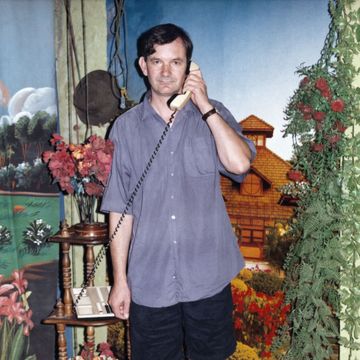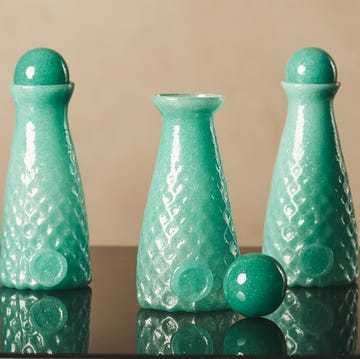The pulse of London’s design scene is changing. A burgeoning generation of Black designers – many of them hailing from West Africa – are forming a movement that recentres African narratives within a contemporary context. Spearheaded by British-Nigerian Yinka Ilori, who made the brightly patterned visual language of Nigeria his signature motif, the cohort includes Tejumola Butler, Bisila Noha and Omotunwase Onaike.
Africa’s rich landscape, traditional folk tales and ancestral legacy are the linchpins of their work, while materials and manufacturing play a role in spotlighting African craft. These younger practitioners, many of whom emigrated to London to study, lean into the capital’s preoccupation with innovation and use their experience of living in our multicultural city to create stories that uplift, enlighten and inspire.
Tejumola Butler
Butler, who was born into a family of blacksmiths, grew up in a small town in southwest Nigeria called Ijebu-Ode, before moving to London to study design at Ravensbourne University. Through his work, he wants to celebrate the changing face of his native country. ‘I want my work to spotlight West African modernity. Things have changed a lot now and Nigeria’s design scene is a big deal.’ He references Hublot Design Prize winner Nifemi Marcus-Bello and Frieze exhibitor Myles Igwe as examples leading the Nigerian charge.
What's everyone reading?
‘Jesmonite Arch Lamp’, Butler’s breakthrough piece, is a tribute to the rock formations found across the country of his birthplace. ‘The lamp’s shape and texture are reminiscent of rugged surfaces, especially limestone, capturing the essence of their time-worn beauty,’ he explains. ‘The natural contours and patterns found in Nigerian rocks are translated into the lamp’s form, creating an organic and visually striking piece that reflects the majesty of the environment I grew up in.’
Now based in Hackney Wick, Butler is interested in Yoruba metalwork, fuelled no doubt by his upbringing and early exposure to metal making. His latest range of aluminium desks, chairs and lamps is informed by traditional Yoruba techniques. ‘I find great inspiration in Yoruba craftsmanship, renowned for its intricate woodwork, weaving, metalwork and beadwork,’ he says. ‘Its incorporation of symbolism and mythological elements opens up storytelling opportunities. My intention is to create a beautiful fusion of heritage and modernity.’ butlerarchive.com
Bisila Noha
‘I connected with my Blackness and my African roots when I went back to Baney [Equatorial Guinea] to create my collection’, the Spanish artist says of ‘Baney Clay: An Unearthed Identity’, the voluptuous vessels she began making in 2020. ‘It was incredible to feel connected to this land – emotionally, spiritually and physically.’ Each piece is made from clay sourced in the Central African country where her father comes from. Noha then used a combination of throwing and hand-building techniques to produce the collection in her studio in London, the city she has lived in for the past 10 years. Popular pieces include the moon-shaped urn ‘Womb Vessel’ and a two-legged piece designed to reflect Noha’s ‘two cultures’ or dual identity.
The artist has traced her heritage and has since produced ‘Searching for Kouame Kakaha’, a series that sculpts the skills of local artisans and traditional craft techniques into her designs. Now, Noha almost exclusively works with terracotta. ‘It’s a way to reclaim this material that has been considered ‘less than’ in some artistic circles; as well as a chance to mix techniques – throwing and hand-building – to bring together what we often consider either male or female; good or bad; progress or tradition,’ she says.
Her approach has led to some high-profile collaborations, including a tableware range with Heal’s, and has seen her work displayed at the V&A Museum. She is also a member of Design Can, a campaign calling for a more inclusive design industry.
Alongside her recent trip to Baney, Noha believes that living in London feeds her creativity. ‘I feel constantly nurtured from a creative perspective. After 10 years here, I feel like a Londoner, which is nice as a mixed-race woman, having struggled with that sense of belonging in the past [as I was] growing up.’ She is excited about the future: ‘It is all an ever-evolving process. The more I play with materials and techniques, the more inspiration I find around me. I am enjoying myself a lot.’ bisilanoha.co.uk
Omotunwase Osinaike
Since moving from Lagos to London at the age of 15, Omotunwase (known as Tunwase) Osinaike’s career has skyrocketed. The multi-disciplinary designer cut his teeth training at Loughborough University from 2014, and graduated with a master’s in furniture design in 2022. Within a year, he had curated ‘Natural Synthesis’, the Nigerian pavilion at the London Design Biennale. Taking its name from Nigerian artist Uche Okeke’s theory, concerned with art that advances Black perspectives, the pavilion was constructed as a traditional Nigerian courtyard inside Somerset House, with Osinaike’s hand-moulded fibreglass lounge chairs at its centre. It was made to reflect the relationship between the Sahara and the Amazon, seeking to, he adds, ‘remind attendees about their innate duties as planetary stewards and as custodians of a plural society’.
Osinaike’s personal furniture designs have a similar anthropogenic focus, while their forms are often inspired by biomimicry. ‘Whether contending with the wealth of knowledge and excellence embedded within my ancestral codes or reaching curiously and speculatively into an imagined plural future, I’m always in search of the ethereal threads that connect us,’ he muses. His fascination with people and place goes back much further than the pavilion, to his childhood in Nigeria. ‘My desire to study and practice as a designer in London came from an emphasis during my childhood on learning and interacting with the diverse indigenous people in Lagos, a deep interest in geography and early travels to other nations.’
When asked how he believes the British design industry could look in the next 10 years, Osinaike is sanguine, stating that he hopes to witness a much wider understanding and acceptance of the true breadth of work that can be created by Black creatives. ‘Black designers are of many kinds, with just as many definitions, approaches and categories,’ he says. ‘I believe the industry should increasingly acknowledge this heterogeneous nature and complexity.’ @tunwasethalisosinaike


















